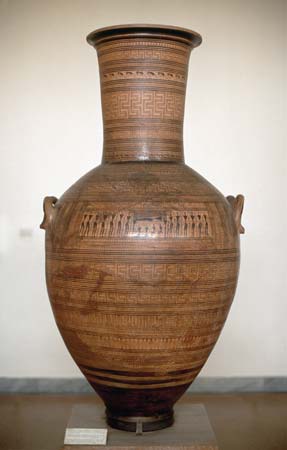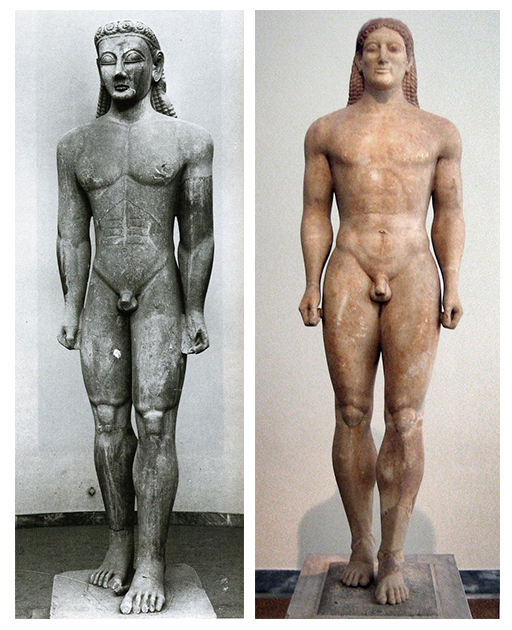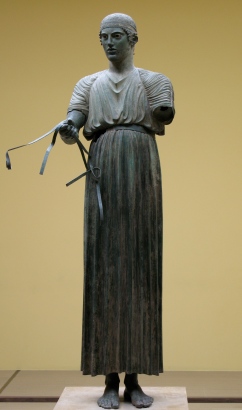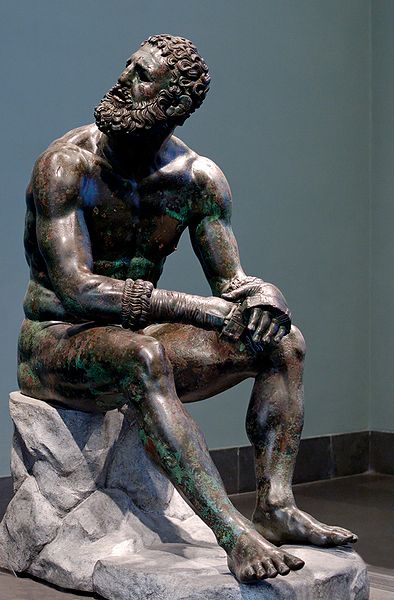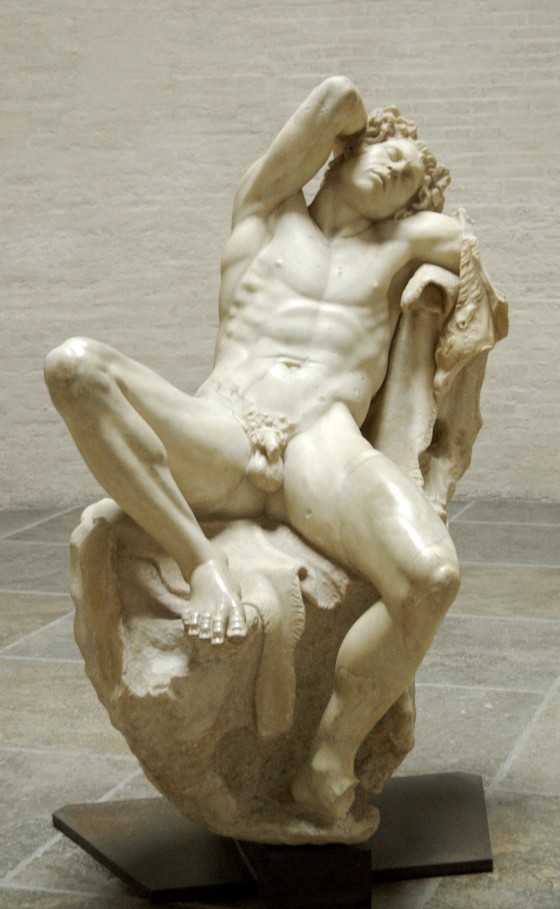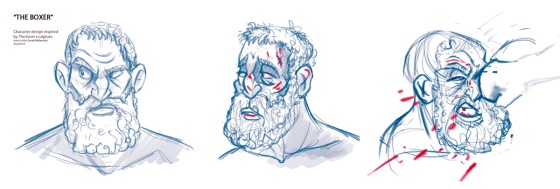Evolution of the Ancient Greek bronze statues: Archaic, Classic and Hellenistic period.
The dignity and beauty of the individual human being and the rich texture of physical and psychological interplay among human beings constitute at once the subject, the goal, and the final determinant of Greek artistic and literary creation.
http://www.ancientgreece.co.uk/geography/story/sto_set.html
In this post, we are going to go through the four art periods of Greek culture regarding the representation of the human form and its evolution from the Geometric to the Hellenistic period. But first, we must know the foundation of the Greek society. Democracy, autocracy, tyranny, aristocracy, oligarchy and monarchy had been practiced in Greece, finally adopting the polis, the independent city-state and primary unit of the Greeks. The city state is basically the division that the world has today: a city with its surrounding territory. Although they passed trough different politic regimens, their ideal was self-government. The city-states led to innovation in many different topics: politics, literature, painting, sculpture, architecture, athletics, religion. There are four art periods, distributed in a 900 hundred years of growth, learning and experimentation, so let’s dive into the topic by looking at the timeline below:
Greek art timeline. Ancient Greece, 1000 B.C.–1 A.D. In Heilbrunn Timeline of Art History. New York: The Metropolitan Museum of Art, 2000
Amphora painted in the Geometric style. 750 B.C.
Having Egyptian art as background and as the strongest influence of this period, the geometric style of Greek art lives now in pottery and very few sculptures, indicating a fairly low cultural development on this time lapse. The amphora (vase used to contain oil or wine) is an interesting example, which depicts the human figure composed by triangles (representing the torso) and lines in a very stylised and simplified way, highly influenced by Egyptian art. Another way to identify the geometric period is the composite view, a very important feature of this period,showing the figure from multiple views (side view of feet and legs, front view from chest, side view of the head), probably trying to illustrate more clearly the body parts and silhouette. The pottery objects found today are those representing funerals, sea battles, dancing or boxing matches.
Left —Kouros of Sounion. 600 B.C. 3.05m of height. National Archaelogical Museum, Athens.
Right — Anavyssos Kouros. 525 B.C. Marble. 1.93m height. National Archaeological Museum, Athens.
Creative and in constant evolution, this period is a huge jump in terms of form, content and artistic technique, resulting in a more accurate and naturalistic appearance in sculpture and painting. The ideology behind this art period was that your body was an expression of your inner being, where your body was directly connected to your mind. That way, the perfection of human figure also meant to have a perfect mind. In the early years of the archaic period, we can still see a direct influence of Egyptian art, commonly seen in the Kouros of Sounion or Anavyssos Kouros, directly copying the rigid stance, stepping forward. Another interesting feature and characteristic of archaic sculptures is the Archaic smile or Archaic grin, which repeats through multiple art pieces either if the figure was standing, in battle or in a everyday activity. We can also notice that most of Greek sculpture is of the male figure, completely nude, corresponding to the way that men were seen among Greek society (nude in public spaces). The few women sculptures that exist today, they are seen fully clothed. Also, they are constantly looking at the viewer, as if they were posing for a photograph, the complete opposite of the Hellenistic emotional approach.
Charioteer of Delphi, from the sanctuary of Apollo. 470 B.C. Bronze,1.8m height. Archaeological Museum, Delphi.
There is a big transformation and evolution from Archaic to Classical period, also known as the Severe style. Classical sculptures have their own mind. They are not looking at an audience, but thinking. There’s a better study of the dynamic pose and stiff and rigid figures are mostly gone. Even in standing position, the sculptures have a sense of weight and movement, using contrapposto (the figure stands at rest, with the weight placed on one leg)for a more interesting and naturalistic look, making the angle of the pelvis asymmetrical. The Greek also applied mathematics and proportions to create the idealised figure, exaggerating some body features that would help to represent the perfect proportion.
One of the big differences in this period is that the Archaic grin has lead the way to a more passive, serious and calmed expression for the sculptures, which may be interpreted as a naturalistic approach of the human mind (not smiling at a ”camera”; instead, the subject is unaware of the audience. apparently thinking or maybe just being cool). An example of this is the Charioteer of Delphi, a bronce sculpture that originally had the character standing in a bronze chariot controlling four bronze horses, but today only fragments of the horses survive. We can also admire the pinnacle of the classical Greek figure when looking at the Two warriors, bronze sculptures found in the bottom of the Ionian Sea that show the master craft of this period. Each one used to hold a spear or a sword on the left hand and a shield on the right arm, magnifying the feeling of power that the standing pose already presents.
Two warriors. 460-450 B.C. Bronze. Height approx. 2.03m. Museo Archeologico, Reggio Calabria, Italy.
Portrait of Alexander. 1st half of 2d century B.C. Marble, 41cm. Archaeological Museum, Istanbul.
After the death of Alexander The Great, the kingdom that he established all the way through middle east and Egypt was divided among his generals, who later ruled as kings of their own province. The cities began to decline, and so did their cults to the Greek gods. A mix of beliefs and gods took over, like the cult of Isis or Cybele. Despite all this, the cities grew in knowledge, learning and the demand for art became even bigger. We must think that this was the former Greek empire, and Greek artists were spread all over the provinces. The content of art though, has nothing to do with the passive representation of the Classical Greek human figure. Hellenistic art wraps emotion:drama, sensuality, violence. This emotions were portrayed explicitly with the beautiful craftsmanship of the classical period, which resulted in highly elaborate masterpieces. Historians have defined the start of this age with the sculpture of Alexander (head), who was the fire starter behind this new period of art.
Seated boxer. Middle 1st century B.C. Bronze, 1.27m height. Museo Nazionale Romano, Rome.
Satyr. 220 B.C. Roman marble copy of Greek original, over life size. Staatliche Antikensammlungen und Glyptothek, Munich.
An important characteristic of Hellenistic sculptors is that they did not distanced themselves from a real portrayal of human life, which can exemplified with the Seated Boxer. Instead of a gracious and perfect god-like athlete from the classical period, we can see a defeated and maybe humiliated boxer with a broken nose, cauliflower ears, swollen cheeks and even cuts in his face. His expression reveals sadness, magnified by the depth of his eye sockets which cast dramatic shadows around the area.
The Hellenistic sculptors also took care of creating mythology characters, such as The satyr, a party-hard and irresponsible creature (usually portrayed with goat legs) but from a naturalistic point of view. In the image we can see that the satyr is lying down, asleep and possibly drunk from last night’s party, but we can also see the level of detail and emotion seen in The boxer sculpture.
The naturalistic approach of the Hellenistic sculptures is rich in appeal, form, value and composition. All the sculptures share the same amount of detail regarding pose, emotion and anatomy, which drives us to think of the incredible amount of time and perfectionism the artists had. Let’s begin with a general guide of formal elements used in this art period:
Shape. The anatomy and shape of the muscles that affect the surface of the skin are highly detailed, along with the facial expression and feeling of the subject, resulting in idealised figures that are not just for display, but emotionally in action and movement. The shape of the hair, that was so unrefined in the first two art periods now has a detailed volume and weight.
Composition. We can see how the natural ”S” curve and “C” curve are an important element in the line of action of the characters. The rigid stance, proud and controlled, has been replaced by activities and everyday situations of ”common” people (they all have the idealistic type of body done in the Classical period”) in different states of mind. The classical artist would have never done anything like this.
Texture and pattern. We can see that some of the patterns made by shapes have prevailed in the detailed hair and beard of the characters. Greek sculptures were made mostly out of bronze or marble, obviously showing up nowadays with the absence of the paint work.
It’s important to note that all of the Greek sculptures (if not all of them) were painted. The Greeks applied much effort to painting as they did in sculpting. There are many sources discussing the understanding of color in Greek art, but we definitely do not know for certain the exact hues they used (although there are a couple of photoshop examples found here and here). I am not a fan of these photo manipulations, but german archaeologist Vinzenz Brinkmann has already studied many statues of the Temple of Aphaia, making interesting discoveries regarding color, patterns and ornamentation created just with the paintwork. On the next quick video, we can actually see this patterns popping out of the sculpture when ultraviolet light is applied near the surface.
According to Edith Anderson in her book Colour: How to use colour in art and design, The Greek color ”has its foundation in that used by the Egyptians but with several changes: white, light brown, purple, black, yellow, yellow-orange, gray, green and blue […]. The ancient Greeks developed white lead, verdigris and vermilion […]. Tyrian purple, the imperial purple of the Romans, was first used by the Greeks. As plato makes clear in the Republic, it was used by the ancients for major rites of passage, such as births, deaths, and marriages, and regarded by them as the mos beautiful color of all, in part because it was held to contain equal proportions of dark and light.”
There’s too much to analyse about the Greek figure, but fortunately we can do so with the remaining sculptures and paintings that exist nowadays. Hopefully this brief description will give us a glimpse of each period, in order to identify and differentiate one from another. Finally, for the sake of fun and paying my respects to my favorite sculpture of the Hellenistic period, I tried to re-imagine The boxer as a potential character in an 2d animation world. Just had fun with a couple of expressions before and after his match.
Related Post
A shocking documentary proves that mermaids do exist
SHOCKING Revelation: Thuya, Mother of Queen Tiye, Was the Grandmother of Akhenaten and Tutankhamun—What Ancient Egyptian Secrets Did She Leave Behind?
Breaking News: Astonishing Discoveries at Karahan Tepe Confirm an Extraterrestrial Civilization is Hiding on Earth, and NO ONE Knows!
Breaking News: Researchers FINALLY Discover U.S. Navy Flight 19 After 75 Years Lost in the Bermuda Triangle!
NASA’s Secret Investigation: Uncovering the Astonishing Mystery of the UFO Crash on the Mountain!
Explosive UFO Docs LEAKED: Startling Proof That Aliens Ruled Ancient Egypt!


